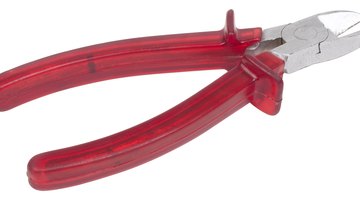How to Wire an A/C Unit
Wiring an A/C unit involves installing a double-pole, 240-volt circuit breaker in the main service panel, running a 240-volt cable to the A/C's location, installing a safety-disconnect switch there, and then running weatherproof flex from the switch to the A/C's terminal box.

This isn't an especially difficult project but it will involve applying for an electrical wiring permit from your the building department, working with the NEC (National Electrical Code,) and using some basic applied math. The most difficult part of this project will be routing the cable from the service panel to the safety-disconnect switch. This may involve fishing the cable through finished walls and floors/ceilings.
Things You Will Need
- NEC (National Electric Code,) NFPA (National Fire Protection Association,) Publication 70, Revision 2008
- 3-conductor w/Ground, type UF cable
- 2 cable connectors
- Stranded copper building wire, red
- Stranded copper building wire, black
- Stranded copper building wire, white
- AWG 12, solid copper building wire, green or bare
- Liquid-tight flex conduit
- 2 liquid-tight flex connectors
- Wire pulling tape/wire fishing tape
- Wire nuts
- Double-Pole, 240-volt circuit breaker
- Safety-disconnect switch
- 3/8-inch, battery-powered drill/driver
- Drill bits (Masonry bits and spade bits)
- Phillips head screwdriver bit
- Level
- Electrician's screwdrivers
- Cable cutters
- Electrician's knife or razor knife
- Diagonal pliers/wire cutters
- Lineman's pliers/Electrician's pliers
- Wire strippers
- Needle nose pliers
Planning the Installation
-
Locate the nameplate on the A/C unit and note the specifications for the "Continuous Duty Full Load Current" and/or the "Branch Circuit Selection Current."
-
Calculate the minimum required Ampacity (Ampacity refers to the maximum current that a conductor of a given size can carry safely) for the branch circuit conductors by multiplying the "Continuous Duty FLC (Full Load Current)" or the "Branch Circuit SC (Selection Current,)" whichever is greater by 1.25, per NEC Article 440.32.
-
Compare the computed value with the values given in NEC Table 310.16, column one. If the computed value falls between two listed values, select the wire size with the next higher rating.
-
Calculate the minimum rating for the safety disconnect switch by multiplying the "Continuous Duty FLC" or the "Branch Circuit SC," whichever is greater by 1.15 per NEC Article 440.12(A)(1.)
-
If this minimum rating falls between two standard ratings, select the next higher rated switch.
-
Calculate the minimum circuit breaker rating by multiplying the larger of the two current ratings by 1.25 per NEC Article 210.20(a).
-
Compare this value with the values given in NEC Article 240.6. If the computed value falls between two standard ratings, select the higher rated circuit breaker.
-
Apply for your wiring permit. Don't start the wiring until the permit arrives.
Wiring the A/C Unit
-
Mount the safety disconnect switch next to the A/C unit.
-
Route the type UF cable between the service panel and the safety-disconnect switch.
-
Install a cable connector in one of the safety switch's bottom knockouts.
-
Remove 12 inches of the cable's outer jacket and secure the cable in the connector by tightening the clamping screws.
-
Route the red and black circuit conductors to the top of the switch, strip off ¾ inches of insulation, and attach them to the main switch lugs.
-
Attach the white circuit neutral conductor and the green/bare-grounding conductors to the switches neutral and grounding bars, respectively.
-
Install liquid tight connectors in the switch and the A/C terminal box and make up the flex.
-
Install liquid tight connectors in the switch and the A/C terminal box and make up the flex.
-
Secure the flex to the switch and attach the red and black conductors to the bottom lugs on the switch. Attach the neutral conductor and the system-grounding conductor as you did above in step 8.
-
Attach the flex to the terminal box and make up those connections by attaching the conductors to the appropriately marked terminals.
-
Remove the cover to the service panel and install the double-pole breaker.
-
Install a cable connector and the cable in the service panel.
-
Connect the red and black circuit conductors to the circuit breaker terminals.
-
Connect the neutral and ground conductors to the service panel's neutral and grounding bars. Only one wire per screw or your installation will fail inspection.
-
Call the local government building department for inspection.
The Drip Cap
- Wiring an A/C unit involves installing a double-pole, 240-volt circuit breaker in the main service panel, running a 240-volt cable to the A/C's location, installing a safety-disconnect switch there, and then running weatherproof flex from the switch to the A/C's terminal box.
- Calculate the minimum required Ampacity (Ampacity refers to the maximum current that a conductor of a given size can carry safely) for the branch circuit conductors by multiplying the "Continuous Duty FLC (Full Load Current)" or the "Branch Circuit SC (Selection Current,)" whichever is greater by 1.25, per NEC Article 440.32.
- Compare the computed value with the values given in NEC Table 310.16, column one.
- If the computed value falls between two listed values, select the wire size with the next higher rating.
- Apply for your wiring permit.
- Install liquid tight connectors in the switch and the A/C terminal box and make up the flex.
- Connect the neutral and ground conductors to the service panel's neutral and grounding bars.
References
Resources
Writer Bio
Based in Colorado Springs, Colo., Jerry Walch has been writing articles for the DIY market since 1974. His work has appeared in “Family Handyman” magazine, “Popular Science,” "Popular Mechanics," “Handy” and other publications. Walch spent 40 years working in the electrical trades and holds an Associate of Applied Science in applied electrical engineering technology from Alvin Junior College.
Photo Credits
- Hemera Technologies/PhotoObjects.net/Getty Images
- Hemera Technologies/PhotoObjects.net/Getty Images
More Articles



